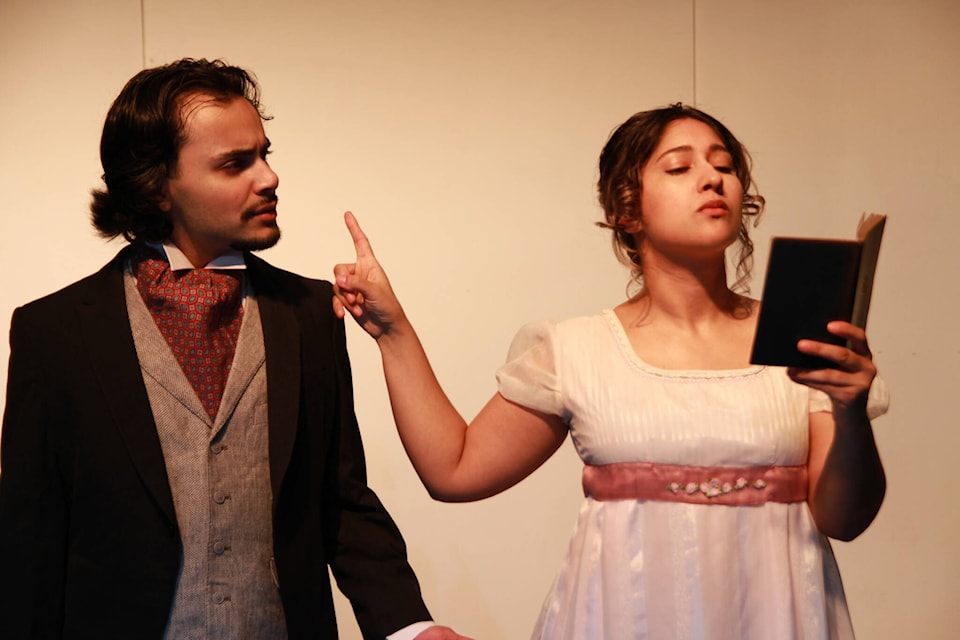White Rock Players Club’s most recent production at the Oceana PARC Playhouse – American playwright Kate Hamill’s adaptation of Jane Austen’s Pride and Prejudice (Feb. 15 to March 3) – was noteworthy on several levels.
The energetic ensemble piece succeeded in drawing full houses – of widely varying ages – to live community theatre; no mean accomplishment in this day of ubiquitous distraction.
In director Alaina Holland’s very capable hands the production managed to capture most of the fun inherent in Hamill’s cheeky modern take on the material – if stopping just this side of the absolute conviction required, on a professional level, for such an audacious approach.
Pride and Prejudice also served as a great example for local producers and directors of thinking outside the box – or rather outside the ‘box-set.’
READ MORE: Austen classic becomes comedic romp in White Rock
Holland’s clever set design utilized a few furnishings and three rotating background units – with multiple folding panels well-painted by Sarah Anderson, among others – to accomplish scene changes. This, plus lighting cues and the playing of the ensemble through and around them, managed to convey changes of setting and time with no apparent hindrance to the understanding of the audience.
But perhaps the biggest laugh of all was had by Jane Austen herself. Even with Hamill’s savvy commentary on the differences – and sad similarities – between women’s roles in 19th and 21st century society; even with humorously anachronistic music and dance (choreographed by Laura Ross) and all the modern bells and whistles (and there were bells galore on this production’s sound effects stand), Austen prevailed.
Her basic plot, and the character evolutions within it, still wield considerable dramatic power and were, I suspect, what ultimately kept audiences enthralled to the end.
The story is well known. In Regency England, Mrs. Bennet is obsessed with ensuring her family’s future by marrying off at least one of her daughters to a wealthy man.
But her eldest, Jane, worries that being too enthusiastic about a prospect will be unseemly, while the next eldest, Elizabeth, decries her mother’s machinations as a ridiculous “game.”
The alarmingly awkward Mary seems to have little hope of attracting a suitor, while the youngest, Lydia, only 14, is frighteningly immature and impressionable.
Into their orbit come the extremely wealthy Mr. Darcy; Mr. Wickham, a smooth-talking army lieutenant; the enthusiastic Mr. Bingley; and obnoxious clergyman Mr. Collins, more eager than discerning when it comes to choosing a wife.
At the core of the story is the relationship between Mr. Darcy and Elizabeth, which, while it appears to be a case of disdain at first sight, evolves gradually into something approaching romance.
Mallory Hema did an excellent job in painting an accessible and likeable Elizabeth, who, while bluntly outspoken on the surface, is a mass of uncertainties beneath. She also developed a convincing romantic chemistry with Amrit Sandhu, equally fine as the gravely pompous, but easily misunderstood, Darcy.
Also notable in this version of Pride and Prejudice were two double roles that crossed gender lines, particularly since the casting allowed the players to provide some implied commentary on their ‘male’ roles, in keeping with Hamill’s re-imagining of the novel.
Holly Collis Handford stole scenes left, right and centre throughout the play. As the “scary” sister Mary, she captured the sadness of a personality excluded from so much of the conversation, while at the same time possessed of very penetrating insight. And, in frequent, funny turns as Elizabeth’s eager, puppy-like suitor, Mr. Bingley (capable of being distracted by a thrown ball, and responsive to commands to ‘sit’) Hanford positively lit up the stage.
Michelle Collier, effective as Bingley’s haughty sister, also enlivened the production with her wicked depiction of a wheezily randy Mr. Collins, a walking thesaurus forever adjusting his pronouncements.
As Lydia, Abrielle Dumansky was all shrieks and squeaks – almost to the point of unintelligibility. While I felt this over-the-top approach tended to work against the humour of the role, the same player came into her full comedic strength with her promising portrayal of the imperious, constantly posing, fashion plate Lady Catherine De Bourgh – a performance all the more amusing for its disciplined restraint.
Alexandra Quispe turned in a touching performance as the quiet Jane Bennet, and scored laughs as the heavily-veiled, twittering Miss De Bourgh. Madison Willoughby was also quietly effective in finding the pragmatism of Elizabeth’s close friend Charlotte Lucas, while Michael Kirk was suitably unctuous as the unfortunately unreliable Wickham.
Lisa Gach was funny as the alternately gleeful and despairing Mrs. Bennet – proving herself capable of finding as many laughs in a single look as in one of her character’s many overwrought declarations.
And last, but certainly not least, Chris Carvelli was in fine comedic form, helping to weave the show together with his performance as the long-suffering Mr. Bennet – happiest when perusing his newspaper, and prone to many sighs, but moved, when ultimately necessary, to put his foot down.
Various servants and footmen kept the production ticking along and added to the atmosphere.
In that context, mention must be made of Eve Partridge’s well-informed costume designs, which while not pretending to be button-perfect replicas of early 19th century garb, did the all-important job of evoking the Austen era.
